Carlo Gesualdo, the Murderous Composer
Carlo Gesualdo (1566 – 1613), Prince of Venosa, was an Italian Renaissance nobleman and composer widely renowned amongst music aficionados for his compositions that were centuries ahead of their time. The beauty of his famed madrigals is eclipsed only by the savage ferocity with which he committed one of the most notorious acts of violence in the history of western music.

Gesualdo had long been acquainted with Donna Maria D’Avalos, his first cousin, but it wasn’t until the year 1586 that her beauty overwhelmed him and he took her hand in marriage. Several years into the marriage Donna Maria began an affair with the Duke of Andria that was well known to many, but not to Gesualdo. It took two years before news of the affair reached him, at which point he resolved to catch the lovers mid-tryst. In 1590 Gesualdo allegedly left on a hunting trip and, once the lovers were in each other’s arms, burst into the bed chamber and stabbed the two where they lay (some reports even alleging that Gesualdo forced the Duke to don the lady’s eveningwear before he slaughtered the emasculated interloper).
Far from keeping the violent affair out of the public eye, Gesulado strew the remains of his wife and the Duke in front of his Florentine manor for all to see. The murders, in fact, became fodder for the Renaissance equivalent of a media frenzy, inspiring a generation of tawdry and sensationalistic poetry. This publicity did little to put Gesualdo’s freedom in danger since noblemen of the day were immune from legal prosecution. He was, however, officially censured by the Vatican, which issued the claim that Gesualdo’s violent acts betrayed, “secular perversions and a lurid internal conflict setting decency and morality at the feet of carnal desires.” Despite the disapproving glare of the Vatican, Gesualdo went on to produce some of his most cherished composition in the 23 years between the murders and his death. These years were marred, however, by a debilitating depression that caused a desperate Gesualdo to go as far as ordering his servants to physically beat him on a daily basis.

The relationship between creative genius and the propensity for brutality is a common theme in the evaluation of historically significant artists. The self-mutilation of Vincent Van Gogh, the bloody suicide of Earnest Hemingway, the reckless, pistol-waving outbursts of Phil Specter. These well-known instances illustrate the savage potential associated with the sharpest creative minds. Authors Cecil Gray and Philip Heseltine summarized this coupling of notions well, in this case focusing specifically on musical creativity, in their book Carlo Gesualdo, Prince of Venosa, Musician and Murderer:
“But more particularly is there a definite connection between music and murder, although it may not be readily apparent. Not that many musicians have actually committed murders (apart from Gesualdo, one can only think of Salieri who, as everyone knows, poisoned Mozart); nor, strange to say, have many musicians been murdered themselves, except Mozart and Stradella. The connection between the two activities is much more subtle but nonetheless close. In the first place, the significant fact should be noted that the beginning of the decline of murder as an art dates from precisely the same period as the development of music as a personal expression, i.e., the beginning of the 17th century. In the middle ages music was more a craft than an art, because the emotions which we now express in music were then actually expressed in life. In these good old days one committed a murder if one felt like it, and thought no more about the matter; today we write an Elektra or a Cavalleria Rusticana instead, in order to work off our feelings. In definite relation to the increased difficulties attendant upon the practice of murder, music has become more and more sadistic. In place of inflicting the utmost pain on a single individual, we outrage the ears of thousands.”
Some Further Reading:
An entry from Reference.com about Gesualdo
An essay focusing on Gesualdo the murderer
Nixon’s Apollo 11 Contingency Speech

On July 20, 1969, two American astronauts aboard the Apollo 11 Lunar Module became the first human beings to set foot on the surface of the moon, dealing a massive blow to the USSR (which only 12 years earlier had bested the United States with the launch of the Sputnik 1 satellite, sparking the Cold War “Space Race”). The Apollo mission was a success and the astronauts returned home unharmed. However, since this mission involved the use of new technology, there was no guarantee that everything would go smoothly. Just in case a malfunction left the astronauts trapped in space with no way to return home, president Nixon had the following speech prepared.

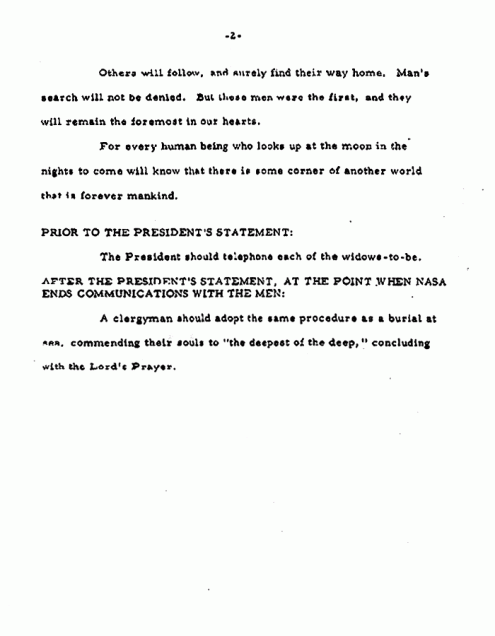
Neil Armstrong and Buzz Aldrin are the only two astronauts mentioned in this speech, presumably due to the fact that Michael Collins never set foot on the moon, remaining in orbit aboard the command module.
This makes one wonder whether the astronauts aboard Apollo 11 were aware that the president of the United States was prepared to announce their quietus to the world, perhaps in the chilling hours while they were still alive, trapped on the moon’s surface and waiting for their oxygen supply to diminish. This line of thinking also leads to President Obama’s desk, and the contingency speeches perhaps contained within. Have his words announcing nuclear war with Iran or North Korea already been penned? Has he rehearsed what he would say in the event of a coming alien invasion? Of the outbreak of a new plague? Of an impending failure of the national power grid?
Some Further Reading:
A site that looks at White House lost-in-space scenarios
A timeline of the Cold War space race
Links to many different presidential addresses
An article that explores one contemporary astronaut rescue plan
Who Built the Sphinx?
The Great Sphinx of Giza is one of the most famous statues in the world, residing on the West bank of the Nile River near Cairo, Egypt. It measures 241 feet long by 65 feet high, making it the world’s largest known monolith. Along with the Great Pyramids of Giza, the Sphinx is part of the legendary Giza Necropolis.

Mainstream modern history contends that the Sphinx was constructed during the 3rd millennium BC under the Pharaoh Khafra. It is widely believed, in fact, that the Sphinx’s face bears an intentional likeness to that of Khafra. Others contend that the statue was built by Khafra’s father, the Pharaoh Khufu, and was merely repaired or modified by his son (who perhaps altered the statue’s face to resemble his own). Some alternative historians, however, have put forth the claim that the statue was originally built thousands of years prior to either of these Pharaohs, and is historically attributed to them due only to the modifications made to the Sphinx during their respective reigns.
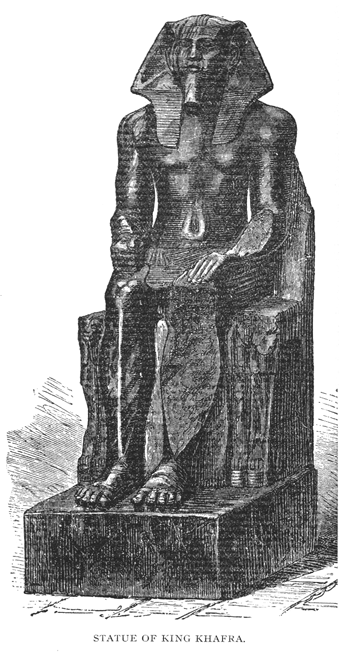
A statue depicting Khafra, currently housed at the Egyptian Museum on Cairo.
The startling lack of any mention of the Sphinx’s construction in the written records of ancient Egypt is cited as evidence for this hypothesis. While the process of designing and building the Great Pyramids of Giza (built approximately contemporaneously, it is widely assumed, with the Sphinx) is extensively outlined in Egyptian records, the only mentions of the Sphinx regard repairs performed on the statue.

The Sphinx's nose is believed to have been carelessly shot off by French or British troops during the 19th century.
French Egyptologist R.A. Schwaller de Lubicz fist noted in the 1950s that the Spinx shows evidence of water erosion that could only have been caused by heavy rainfall over an extended period of time, or perhaps even exposure to flooding. This was a curious observation due to the fact that Cairo is located in a desert climate. The last time that this area of the world is believed to have experience rainfall sufficient to produce the erosion found on the Sphinx was immediately following the end of the last Ice Age about 10,000 – 12,000 years ago, a minimum of 7,000 years before the accepted start of Ancient Egyptian culture. Skeptics shoot down this theory by chalking up the Sphinx’s erosion to the result of acid rainfall or the weakness of the limestone from which the statue was built, and hold fast the the claim that the Sphinx is no older that 5,000 years.
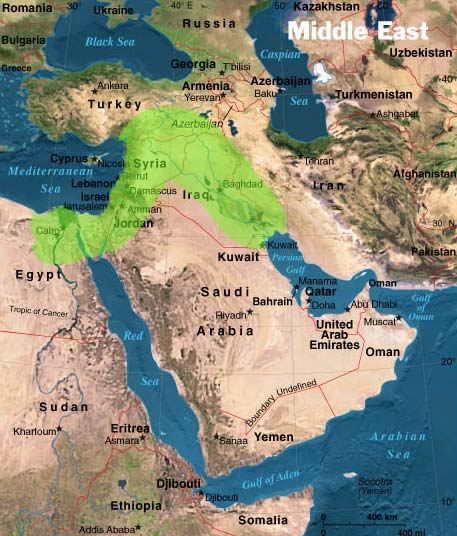
The green areas of this map represent the "Fertile Crescent" where agriculture is believed to have originated about 10,000 years ago (8,000 BC), allowing for the first time in human history the development of sedentary communities. Northern Egypt is covered by the southwestern portion of the highlighted area.
If the Sphinx were in fact built more than 10,000 years ago, this means that it was constructed before the date currently associated with the widespread employment of agriculture, which has been historically equated with a sedentary lifestyle and thus the possibility of civic works. So, assuming (if only for argument’s sake) that the Sphinx was constructed shortly after the end of the last ice age, we must make one of two unprecedented allowances. Either a pre-agricultural “civilization” (I here include the word civilization within quotations because the word’s traditional definition implies a mastery of agriculture) somehow managed to build an astoundingly large and complex statue, or the agricultural revolution took place millennia earlier than it is widely believed to have done so. Perhaps a happy medium can be reached by allowing for the possibility that a culture dating earlier than 8,000 BC mastered agriculture (or at least horticulture) on a scale sufficient to sustain an advanced, sedentary lifestyle while avoiding the trend of expansive totalitarian agriculture. This would allow for the phenomenon to have remained confined within a limited geographical range while the rest of the pre-historic world led a nomadic, hunting-and-gathering existence, unaware of astonishing accomplishments of their North African neighbors.
Some Further Reading:
A site that explores the Sphinx’s origins as mystery
An article containing a cursory description of the Sphinx’s possible origins
An article contending that the Sphinx predates Ancient Egypt
An essay discussing the Sphinx’s possible origins
An essay challenging the notion that the Sphinx significantly predates Khafra
Victorian Postmortem Portraiture

During the Victorian Era (1837 – 1901) in the United States and Europe, a peculiar funerary practice emerged. Due in part to the high youth mortality rates and in part to the recent popularization of daguerreotype photography, it became commonplace to have professional portraits taken of recently deceased loved ones, most commonly children.

These morbid images were often the only glimpses of the deceased that distant relatives ever had the chance to experience. Originally considered luxuries, such portraits became increasingly affordable as ambrotypes and tintypes were developed during the second half of the 19th century.

Since these photographs were meant to serve as memorials of the individual’s lives, the subjects were often formally dressed, fully made-up, and strapped upright in chairs to give them a semblance of vitality. This effect was sometimes enhanced by pink tinting later added to the photographs, making the lifeless faces appear flushed.

It was not uncommon for parents to pose with the corpses of their infants, or for children to surround the remains of their siblings.
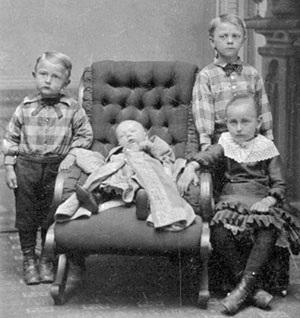
Later examples of postmortem portraiture occasionally depict the deceased propped upright in coffins, simultaneously simulation life and acknowledging the lifelessness of the corpse.

While this tradition has all but vanished in modern day United States and most of Europe, various Orthodox communities in Eastern Europe still practice this form of commemoration, although focusing primarily on distinguished members of their religious communities. There are also some organizations in contemporary America that aim to revive this antiquated tradition. However, due to shifting norms and modern conceptions of death and bodies, photographs of corpses are perceived more as unseemly than as sentimental, evoking shutters of chilled terror in those who occasion to glimpse the open eyes of a lifeless face.
Some Further Reading:
The homepage of the Thanatos Archive, a collection of 19th century postmortem portraits
Earthquake Fish, Earthquake Weather, Earthquake Clouds, Earthquake Light
Appearing in ancient texts from many cultures across the globe, earthquakes have been a source of fear and speculation since time immemorial. With an average of 18 major temblors striking per year (mostly in the Pacific Ring of Fire), it is small wonder that this violent phenomenon has driven humans to desperate attempts at earthquake prediction. While few modern cultures accept, as some once did, that earthquakes are caused by celestial struggles or air trapped beneath the earth’s surface, many still point to early warning signs with origins in ancient mythology. The following earthquake prediction techniques are not supported by mainstream modern science, but are nonetheless widely embraced by individuals and organizations determined to gain a foothold against one of nature’s most destructive habits.
Earthquake Fish

More commonly known as the ribbonfish, these oddly shaped creatures dwell at great depths and commonly measure up to 8 feet long. Taiwanese legend points to these slender fish when attempting to predict earthquakes, claiming that these deep-sea dwellers rise to the surface in the moments before a quake strikes. Modern seismology has shown no correlation between the activities of these fish and actual earthquakes.
Earthquake Weather

Some claim that the Loma Prieta earthquake that ravaged the San Francisco Bay Area in 1989 was preceded by "earthquake weather". This photograph depicts the part of the Bay Bridge that collapsed during the temblor, which was broadcast on live TV due to the fact that the San Francisco Giants were playing in the World Series at the time.
Perhaps the most prevalent folk superstition regarding earthquakes in the modern day United States, the notion of earthquake weather in Western culture dates at least as far back as Herodotus (486 BC – 425 BC). Aristotle wrote about this meteorological phenomenon as well, attributing earthquakes to subterranean winds. Warm, calm weather, he believed, would precede seismic activity. While modern seismologists dismiss this notion as foolish and unfounded, I have personally witnessed this widespread superstition in action. On one unseasonably warm afternoon in San Francisco I was warned by multiple people to be wary, for we were experiencing, they claimed, typical earthquake weather. Fortunately, that day ended without disaster.
Earthquake Clouds

Discussed by Indian scholar Daivajna Varāhamihira as early as the 6th century, peculiar cloud formations are believed by some to rapidly appear in anticipation of earthquakes. Similar observations have appeared in Chinese and European writings of antiquity. These long, slender clouds that have been likened to snakes are said to form in a matter of seconds, acting as a grim premonition to observers below. Modern seismologists are divided about the legitimacy of this prediction technique, which does, at least superficially, seem to show some semblance of legitimacy. These clouds, it is hypothesized, correspond to temperature changes along fault lines that can accompany increased seismic activity and the eruption of heated gasses. The thermodynamic mechanisms by which terrestrial temperature changes affect cloud formation, however, have still yet to be demonstrated in a way that satisfies the scientific community. Until this can be successfully done, earthquake clouds will remain relegated to the realm of superstition.
Earthquake Light

This beautiful luminescence was spotted in the sky over Tianshui, Gansu province about 30 minutes before the Sichuan earthquake of May 12, 2008.
Similar in appearance to the polar aurorae (borealis and austrialis), earthquake light is said to include a wider range of colors. Having been embraced as a harbinger of earthquakes since ancient Greece, several 20th century earthquakes have, many claim, been preceded by these beautiful lights. Minutes before an earthquake struck the Sichuan province of China in 2008, cell phone video footage of these lights was uploaded to the website Youtube.com. Skeptics contend that these lights were merely the result of sunlight refracted by atmospheric moisture. Neuroscientist Michael Persinger has attempted to explain these mysterious lights through his Tectonic Strain Theory, which links seismic activity to electromagnetic fields that can be misinterpreted by human cognition as lights or even UFOs.
While each of these prediction techniques has its fervent proponents, evidence for their reliability is not sufficient enough for them to be employed by the United States Geological Survey Earthquake Hazards Program. This does little, however, to dissuade individuals from looking to ancient wisdom for comfort in the face of a violent force so overwhelmingly powerful that it effortlessly causes the world’s most developed nations to grovel before it in fear. This speaks to the common occurrence of drastic emotion overriding and even dashing to bits all the pristine knowledge of the academic ivory tower. In the face of violent death, sometimes there is only the terrified individual against an indifferent quagmire of external forces.
Some Further Reading:
A frequently updated site tracking earthquake clouds
The United States Geological Survey’s homepage for earthquake information
An article exploring many facets of earthquake clouds
A brief look at the Tectonic Strain Theory
The National Earthquake Information Center
An article proposing a scientific explanation for earthquake lights
A video depicted the earthquake lights that purportedly predicted the Sichuan quake of 2008
The Untimely Demise of Isadora Duncan
 Duncan draped in her signature flowing attire.
Duncan draped in her signature flowing attire.
Widely revered as the originator of modern dance, San Francisco-born dancer Isadora Duncan (1877 – 1927) took Europe by storm during the 2nd and 3rd decades of the 20th century. Her vivacious, bohemian approach to dance served as a popular challenge to the rigid norms of the day, rocketing her to superstar status within dance circles. Ironically, it was this very sense of flair that proved to be Duncan’s undoing.
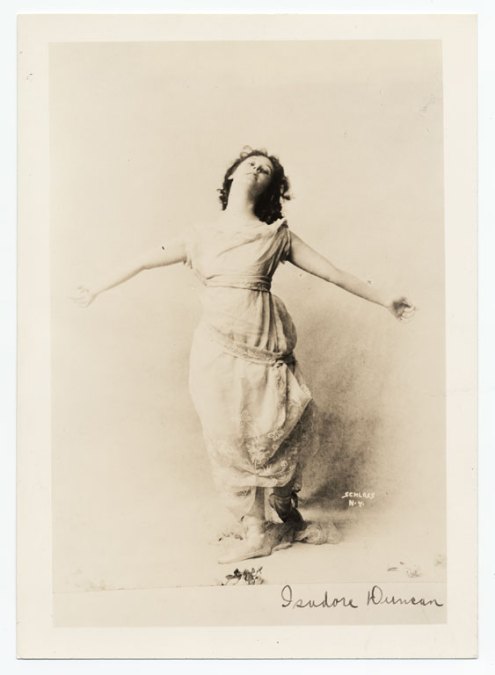
On the evening of September 14 of 1927, Duncan entered an Amilcar driven by her kept man, a dashing Italian mechanic. Giving herself the distinction of being one of history’s few celebrities with well-known last words, Duncan reportedly uttered to a friend, “I am off to love!” (This quote has been widely and incorrectly cited as, “I am off to glory!”) The automobile then sped away.

A 1927 Italian Amilcar automobile.
Duncan was fond of long scarves, one of which flowed behind her on the evening of her violent death on the Riviera of Nice. The end of the silk scarf was blown down to the rotating tire of the speeding car where it was caught. The motion of the tire quickly pulled the scarf taut, jerking Duncan backward with such force that, some reports claim, her head was nearly torn from her body. Her corpse was dragged across the French cobblestones for several moments before the automobile halted. While her death was instant, its legendary status still reverberates in the romanticizing voice box of lore. In life Duncan was certainly a bon vivant, ostentatiously capturing the media’s attention. Is there a homologous phrase denoting one who dies gruesomely while in the public eye? Please reply to this post with any suggestions.
Some Further Reading:
The Isadora Duncan Dance Foundation
A biography of Duncan from the San Francisco Museum
A video of Duncan dancing to a Brahms waltz



